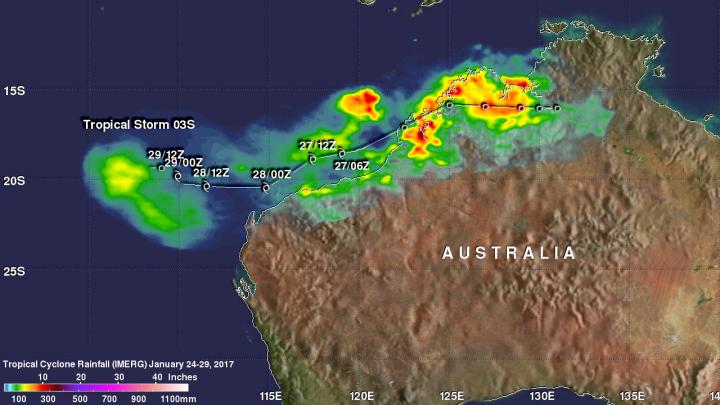NASA's IMERG calculated rainfall of Tropical Cyclone 03S

NASA's IMERG rainfall product provided an analysis during the period from Jan. 24 to 26, 2017.. Rainfall totals of close to 300 mm (11.8 inches) were estimated along Australia's northwest coast. Credits: NASA/JAXA, Hal Pierce
Integrated Multi-satellitE Retrievals for GPM (IMERG) data were used to show rainfall that fell near tropical cyclone 03S.
The highest rainfall totals were found by IMERG as the parent low pressure center moved over northwestern Australia during the period from January 24 to 26, 2017.
GPM is the Global Precipitation Measurement mission core satellite. GPM is a joint mission between NASA and the Japanese space agency JAXA.
Tropical cyclone 03S formed from the low only after moving into the warm waters of the Indian Ocean on January 27, 2017.
IMERG data were used to analyze rainfall that occurred near the parent low and tropical cyclone 03S' centers of circulation. Rainfall totals of close to 300 mm (11.8 inches) were estimated along Australia's northwest coast.
###
To see an animation of this data, visit: https:/
Media Contact
All latest news from the category: Earth Sciences
Earth Sciences (also referred to as Geosciences), which deals with basic issues surrounding our planet, plays a vital role in the area of energy and raw materials supply.
Earth Sciences comprises subjects such as geology, geography, geological informatics, paleontology, mineralogy, petrography, crystallography, geophysics, geodesy, glaciology, cartography, photogrammetry, meteorology and seismology, early-warning systems, earthquake research and polar research.
Newest articles

Trotting robots reveal emergence of animal gait transitions
A four-legged robot trained with machine learning by EPFL researchers has learned to avoid falls by spontaneously switching between walking, trotting, and pronking – a milestone for roboticists as well…

Innovation promises to prevent power pole-top fires
Engineers in Australia have found a new way to make power-pole insulators resistant to fire and electrical sparking, promising to prevent dangerous pole-top fires and reduce blackouts. Pole-top fires pose…

Possible alternative to antibiotics produced by bacteria
Antibacterial substance from staphylococci discovered with new mechanism of action against natural competitors. Many bacteria produce substances to gain an advantage over competitors in their highly competitive natural environment. Researchers…





















